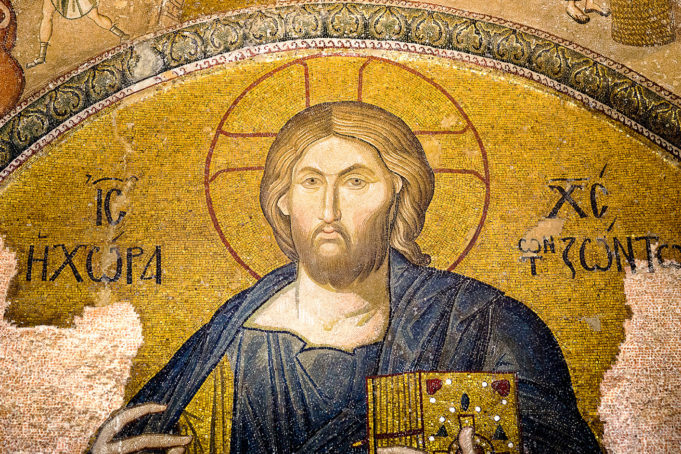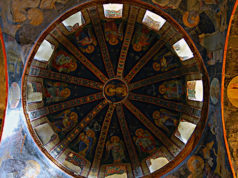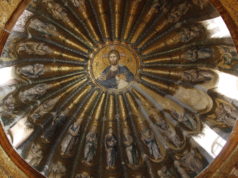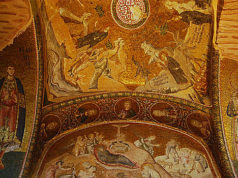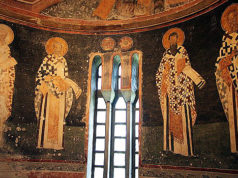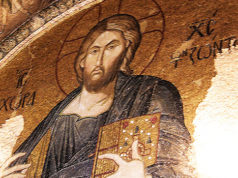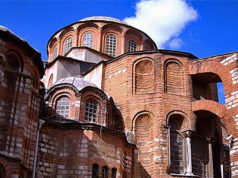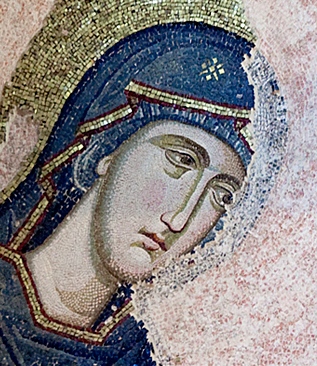 Walk through the door of the Chora Monastery Museum and you step back in time. One-thousand-four-hundred-seventy-three years, to be exact, when Chora was one the many beautiful churches that adorned Constantinople, the jewel in Byzantium’s crown.
Walk through the door of the Chora Monastery Museum and you step back in time. One-thousand-four-hundred-seventy-three years, to be exact, when Chora was one the many beautiful churches that adorned Constantinople, the jewel in Byzantium’s crown.
When it was built, Chora was outside the Walls of Constantine, and so, today, is a bit off the beaten path — away from the long tourist magnets that are Hagia Sophia, the Blue Mosque, and Topkapi Palace.
“Chora,” in Greek, means “rural,” or “in the country,” and the monastery kept that name after it was incorporated within the enlarged Theodosian Walls.
But the name “Chora,” also alludes to another, everlasting, realm: “I Chóra Ton Zónton,” The World of The Living,” proclaims an icon of Christ above the nave door. It’s one of the few mosaics that did not sustain damage during Fourth Crusade 1204 sack of Constantinople.
Evidence of this destruction — and that caused by the passage of 14 centuries — is seen in the bare walls and domes that once were filled with priceless mosaics.
Next to Christ Pantocrator.” (“He Who Holds All,” The Lord of the Universe.) That’s Theódoros Metochites, the man who restored Chora after the Latin invasion.
“Metochitis, a Byzantine poet, scientist, and minister of the treasury, kneels before the enthroned Christ, holding in his hands the restored Chora church.”
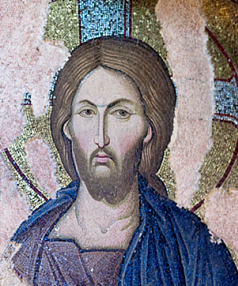 Icon of Christ of Chalke, the Bronze Gate of the Great Palace.
Icon of Christ of Chalke, the Bronze Gate of the Great Palace.
The greatest church in Christendom before St. Peter’s was constructed in Rome 1,000 years later, Hagia Sophia is the very symbol of Byzantium and occupies a special place in the Greek Orthodox heart.
But you don’t have to be Greek to appreciate its beauty and history — as Atatürk, the Father of modern Turkey, did in 1935 when he proclaimed Hagia Sophia a museum. Hagia Sophia’s Deisis (Supplication) mosaic, qualifies it as a World Heritage Site.
The Mother of God, a Chora dome mosaic.
The virgin, clad in a blue chiton, reclines on a purple cushion by a cave housing the manger. The ox and the ass look on as divine light bathes the Child.
To the left of the cave appear angels, and to the right another angelic messenger gives the Good News to the shepherds residing in the fields.
The Nativity is just one of the beautiful scenes from the lives of Christ and the Virgin found in Chora. You could teach a whole Bible class just by walking around and pointing at the mosaics in this beautiful church: besides The Nativity, there are, The Presentation of the Virgin to the Temple, The Annunciation, The Flight into Egypt, The Miracle at Cana, Christ Healing the Leper, The Samaritan Woman at the Well, Christ Healing the Blind Man, Christ Healing the Paralytic, The Temptation of Christ, The Resurrection, treasures all.
The mosaic just below the dome of The Genealogy of Christ, a depiction of the Virgin Mary with Christ of the Chalke, especially moving. Named for an icon of Christ that hung above the Chalke, the “Bronze” Gate, the main ceremonial gate to the Great Palace. Reminiscent of the more famous Hagia Sophia Deisis Christ, this is the face of a benevolent God.
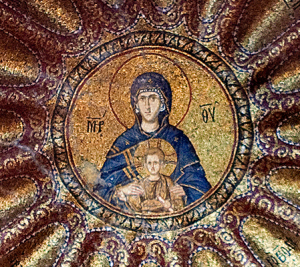
With Avar armies at the gates, those prayers were answered, and Patriarch and people gathered in Hagia Sophia to offer thanksgiving to the Mother of God for The City’s deliverance. (The City, I Polis, as Constantinople was known, is found in the name of Turkey’s largest city and artistic and cultural capital: Is Tin Polin, To The City — Istanbul.)
In thanksgiving was written a beautiful long hymn, Ti Ypermáho, “To the Invincible General.” After a millenium-and-a-half it is still being sung in Orthodox churches for five consecutive Friday evenings before Easter Sunday. An Orthodx hymn that accompanies our Chora video, who’s beloved melody is dear to my soul. Hearing it now brings back Constantinople’s fateful history and The City’s special place in the Greek psyche. A hymn that I find myself humming in front of the Chora mosaic icon of the Mother of God:
Ti Ypermáho Stragigó ta nikitíria,
Os lytrothisa ton dinón efharistíria,
Anagráfo Soi i Pólis sou Theotóke.
All’ os éhousa to krátos aprosmáhiton,
Ek pantíon me kindínon elefthéroson.
Ína krázo soi; Hére Nífi Anímfefte.
“To Thee, Invincible General, I ascribe the victory/Having been delivered from suffering, Your City offers thanksgiving/to You O Mother of God./And having your might unassailable/Free us from all dangers/So we may cry unto you/Hail O Bride Unwedded.”
In the end, there could be no deliverance — 5,000 defenders besieged by 350,000 Ottomans — The City — and Byzantium — fell.


